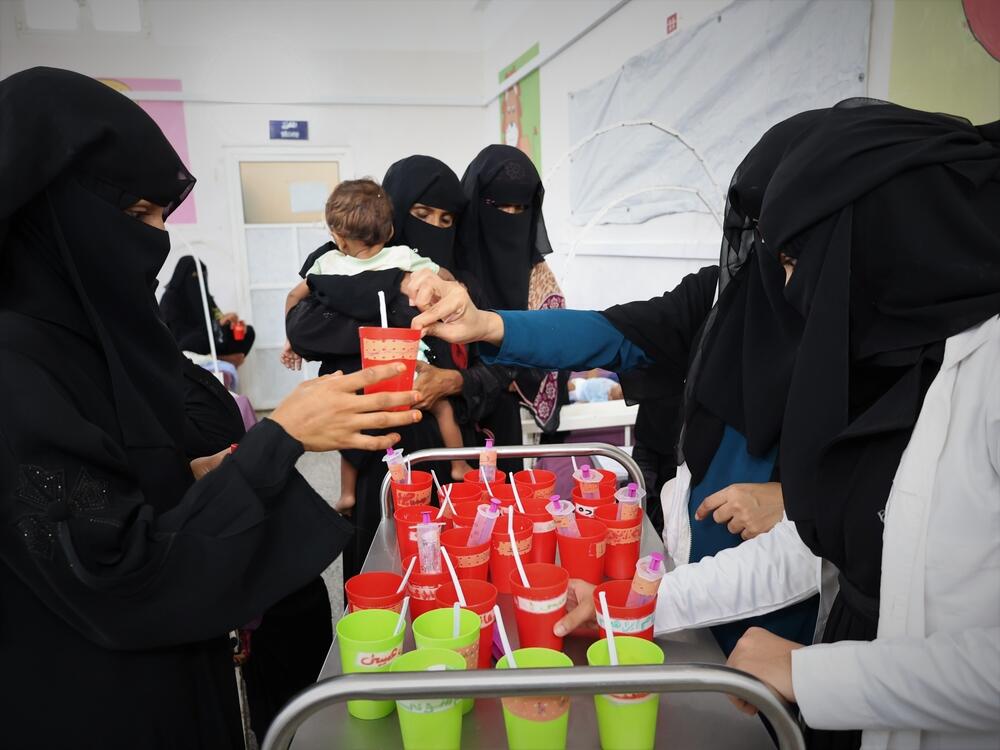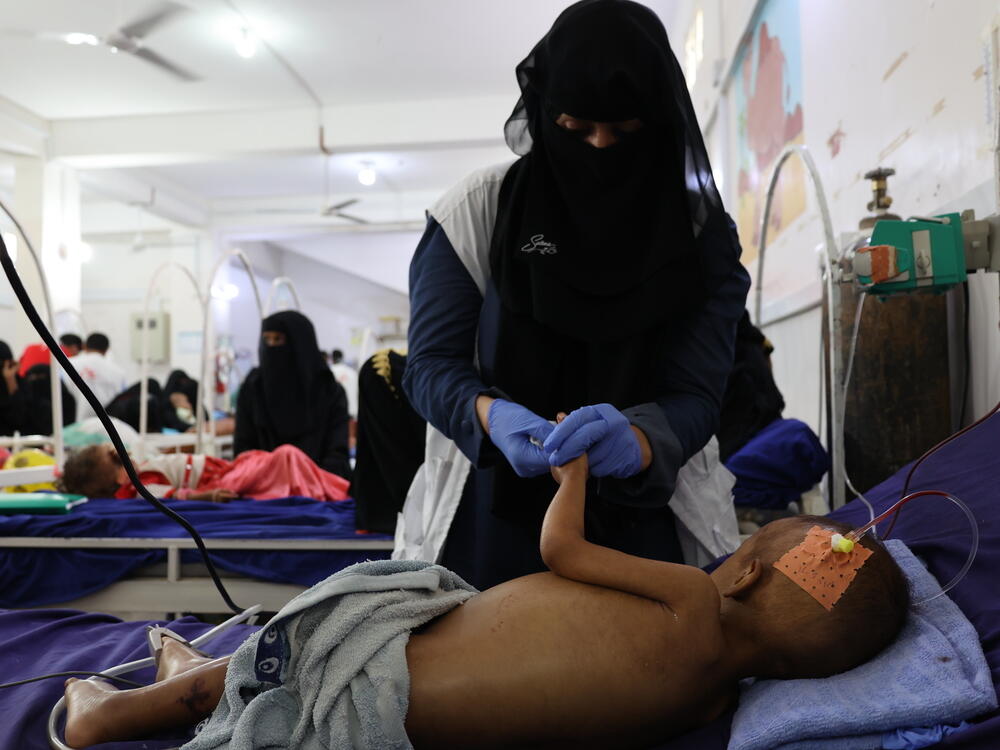Five reasons why acute childhood malnutrition is surging in Yemen
9 December 2022
Key facts:
- Rising childhood malnutrition in Yemen is causing preventable deaths, especially of children under the age of five. MSF responds to seasonal and annual peaks across the country, notably, in Hajjah, Al-Hudaydah, Saada, and Amran governorates.
- Between January and October 2022, 7,597 children with malnutrition came to MSF facilities in Yemen for care, a 36 per cent increase compared to the same period in 2021. Malnutrition in Yemen usually peaks between June and September, but in 2022, MSF teams in several projects documented an early onset of the malnutrition peak in April or May. They’re expecting a prolonged malnutrition peak to continue until December.
- The early onset of the malnutrition peak coupled with high numbers of severely malnourished children needing to be admitted for care has overwhelmed MSF-supported facilities. In some locations, MSF has launched emergency interventions to respond to the surge of acute malnutrition cases and compounding health complications such as diarrhoea, pneumonia, and anaemia.
Malnutrition is a persistent risk to children in Yemen. The country sees seasonal and annual peaks, usually linked to the lean season caused by the disruption of agricultural production in rural areas. This pattern was seen before the escalation of the war in late 2014, but it has worsened due to the direct and indirect effects of the ongoing conflict, which have exacerbated food insecurity for already vulnerable people.
But there is more to it than food insecurity. Here are five major factors MSF teams across Yemen say are contributing to the rise of malnutrition.
1. Reduced affordability of food
Many families in Yemen are unable to afford enough food, nor nutritional food, as Yemen’s deepening economic crisis has caused prices to soar. Many people do not have access to paid work or have lost their homes due to the 8-year-long war, due to destruction, or displacement. The value of the Yemen Riyal [Yemen’s official currency] is depreciating, and food and transportation costs—including fuel—are rising, further impeding people’s access to sufficient food.
“We came to Abs Hospital several times and he was improving,” said Shohra Mohamed, who brought her 4-year-old grandson, Abdullah, who was suffering from malnutrition and other complications to Abs hospital in Hajjah. “The last time he was discharged was 20 days ago. We prefer to come here as the services are free of charge. Abdullah´s father is away. With his mother, we try to feed him with what we have, we rarely can afford to give him milk. We don’t have access to health centres that provide therapeutic food nearby.”
2. Lack of access to primary healthcare services
The healthcare network across Yemen continues to collapse. Limited financial resources of health authorities, shortages of supplies and equipment, no or irregular payment of salaries of medical staff have caused many public health facilities to close. Along with the high cost of fuel, this considerably limits people’s access to urgent medical care. This often delays people receiving much-needed medical care, which leads to complications that could have been prevented if treated earlier, including malnutrition.
MSF teams in Amran governorate working in Al-Salam-Khamer Hospital have seen a steady increase in the number of patients with severe acute malnutrition (SAM) since the end of May. The bed occupancy rate in the inpatient therapeutic feeding centre (ITFC) reached 396 per cent in September 2022. At the same time, there was a more than 20 per cent increase in the number of emergency consultations. Between January and September 2022, 31 patients with SAM died after admission. Most, unfortunately, arrived too late and had medical complications that were too severe to be treated. Many of the people who were admitted to the MSF-supported Al-Salam hospital with SAM, travelled from surrounding areas where the primary healthcare facilities were only partially functioning. A similar trend was observed in Al-Hudaydah governorate. Our team in the emergency department of Ad-Dahi rural hospital received 1,902 children suffering from malnourished with complications, between January and October 2022.
3. Poverty and unstable living conditions
Poor living conditions, especially for those who have been displaced, also contribute to the rise of malnutrition. Abs Hospital in Hajjah Governorate receives patients from the surrounding areas of Abs, where many internally displaced people live without proper shelter and with limited access to food or income. From January to September 2022, the MSF- supported inpatient therapeutic feeding centre (ITFC) at Abs General Hospital admitted 2,087 children with malnutrition and associated medical complications. Many of these patients came from Al-Khamis, a sub-district in Al-Hudaydah Governorate, south of Abs, and several presented late. Most patients were aged between 6 and 23 months.
“Most of the displaced people don’t have a regular income due to difficulties in accessing [employment] opportunities,” said Saddam Shayea, MSF health promotion supervisor at Abs Hospital. “Another issue is the lack of access to clean water. This increases the cases of diarrhoea for example, in addition to the lack of hygiene materials that are essential to reduce the risk or limit the spread of some diseases.”
4. Lack of community health awareness
There is a great need to increase access to health promotion for antenatal care (ANC) and post-natal care (PNC), which are directly linked to malnutrition. The poor availability and accessibility of this care is leading to complicated pregnancies, resulting in poorer birth outcomes for both the mothers and the newborns. For example, in Abs Hospital, in 2022, more than 50 per cent of mothers in the maternity department, were suffering from malnutrition.
In the past, MSF has observed a very low level of women in the maternity ward who received antenatal care (ANC). In 2021, only 10 per cent of women who delivered in the hospital had attended at least one antenatal care consultation. Antenatal consultations are usually an opportunity for malnutrition in pregnant women to be identified and treated through referrals to appropriate nutrition services. This improves pregnancy outcomes and reduces the risks of malnutrition in newborns and infants.
In addition, there is limited awareness in the community about the importance of breastfeeding and routine vaccinations for children. Parents also don’t have access to information about identifying the initial symptoms of malnutrition, which delays the detection and prevention of malnutrition.
5. Gaps in the humanitarian response
This year, funding cuts have caused primary healthcare facilities to discontinue services or have insufficient supplies of medications.
"I have four children who were all suffering from malnutrition,” said Ahmed Abu Al Ghaith, a father who brought his one-year-old daughter suffering from SAM to the Ad Dahi hospital. “I took them to the nearest malnutrition treatment centre in the area. But they had to choose and prioritize among my children to give them some therapeutic food as there was not enough.”
In addition to the discontinuity of some health programs, gaps in nutrition and food assistance programs, and inadequate water, sanitation and hygiene (WASH) services have increased the risks of malnutrition and related complications, which are greater with water-borne diseases.
Responding to the increased numbers of malnutrition patients
MSF works in 13 of Yemen’s 21 governorates. MSF’s teams in most of our facilities have witnessed a concerning surge in the number of malnourished children with medical complications. This has pushed bed occupancy rates well above 100 per cent capacity across our ITFCs. To cope with the increased numbers of malnutrition cases and to reduce morbidity and mortality among those most vulnerable, our teams are scaling up their capacity across projects in the ITFCs and other departments, increasing their support to primary health care centres, and increasing health promotion activities.
In Amran governorate, Al-Salam Hospital has rolled out an urgent contingency plan in the pediatric departments since June 2022 to cope with the increased malnutrition admissions. The total bed capacity is now 213 beds, compared to the usual 113 beds.
Similarly, in Al-Hudaydah governorate, to urgently address the dramatic rise in acute malnutrition cases in Ad-Dahi district, MSF has scaled-up access to malnutrition services by establishing a 70-bed ITFC and facilitating free referrals from health centres to the hospital, for eligible malnourished children under five years old. in November 2022 alone, 282 patients suffering from malnutrition with complications were admitted to the new ITFC. Nutrition surveillance is also being strengthened in Ad-Dahi district to ensure early reporting of the nutrition situation and outbreaks.
In Hajjah governorate, after reaching 180 per cent capacity, the Abs Hospital team exceptionally increased the capacity of the ITFC, by using the ministry of health space to cope with the influx of children with malnutrition. In addition, they are now supporting Al-Khamiss Health centre, in Al-Hudaydah, including malnutrition-related services.
However, malnutrition continues to be extremely concerning in Yemen, causing preventable deaths, particularly of children under the age of five years old. Health authorities and humanitarian and health actors must provide a comprehensive response that aims to reinforce the scope and efficiency of nutritional surveillance countrywide. There is a need to address the gaps in primary healthcare facilities to ensure prompt access to care and help build community health awareness to detect the early signs of malnutrition. The response should also include scaling-up vaccination campaigns across the country, especially among children under five years old who remain the most vulnerable.








